Numismatics is the study or collection of currency, including coins, tokens, paper money and related objects. While numismatists are often characterised as students or collectors of coins, the discipline also includes the broader study of money and other payment media used to resolve debts and the exchange of goods. Early money used by people is referred to as "Odd and Curious", but the use of other goods in barter exchange is excluded, even where used as a circulating currency. The Kyrgyz people used horses as the principal currency unit and gave small change in lambskins; the lambskins may be suitable for numismatic study, but the horses are not. Many objects have been used for centuries, such as cowry shells, precious metals, cocoa beans, large stones and gems.

Chandragupta II, also known by his title Vikramaditya, was one of the most powerful emperors of the Gupta Empire in northern India.

The Kanva dynasty or Kanvayana was a dynasty that replaced the Shunga dynasty in parts of eastern and central India, and ruled from 75 BCE to 30 BCE.

Coinage of India, issued by imperial dynasties and middle kingdoms, began anywhere between the 1st millennium BCE to the 6th century BCE, and consisted mainly of copper and silver coins in its initial stage. Scholars remain divided over the origins of Indian coinage.
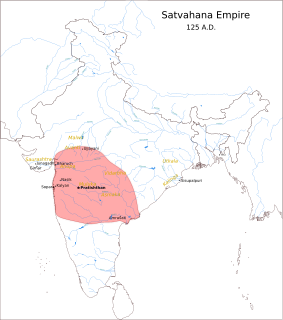
The Satavahanas, also referred to as the Andhras in the Puranas, were an ancient Indian dynasty based in the Deccan region. Most modern scholars believe that the Satavahana rule began in the first century BCE and lasted until the second century CE, although some assign the beginning of their rule to as early as the 3rd century BCE. The Satavahana kingdom mainly comprised the present-day Telangana, Andhra Pradesh and Maharashtra. At different times, their rule extended to parts of modern Gujarat, Madhya Pradesh, and Karnataka. The dynasty had different capital cities at different times, including Pratishthana (Paithan) and Amaravati (Dharanikota).

Strato II "Soter" was an Indo-Greek king. He ruled c. 25 BCE to 10 CE according to Bopearachchi. R. C. Senior suggests that his reign ended perhaps a decade earlier. He may have been supplanted by the Indo-Scythian Northern Satraps, particularly Rajuvula and Bhadayasa, whose coins were often copied on those of the last Indo-Greek kings. Numerous coins of Rajuvula have been found in company with the coins of the Strato group in the Eastern Punjab and also in the Mathura area: for example, 96 coins of Strato II were found in Mathura in conjunction with coins of Rajuvula, who also imitated the designs of Strato II in the majority of his issues.
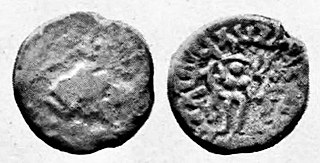
Sodasa was an Indo-Scythian Northern Satrap and ruler of Mathura during the later part of the 1st century BCE or the early part of 1st century CE. He was the son of the Great Satrap of Mathura Rajuvula. He is mentioned in the Mathura lion capital.

The Western Satraps, Western Kshatrapas, or Kshaharatas were Indo-Scythian (Saka) rulers of the western and central part of India. The Western Satraps were contemporaneous with the Kushans who ruled the northern part of the Indian subcontinent and were possibly their overlords, and the Satavahana (Andhra) who ruled in Central India. The power of the Saka rulers started to decline in the 2nd century CE after the Saka rulers were defeated by the south Indian Emperor Gautamiputra Satakarni of the Satavahana dynasty. Later the Saka kingdom was completely destroyed by Chandragupta II of the Gupta Empire in the 4th century CE.
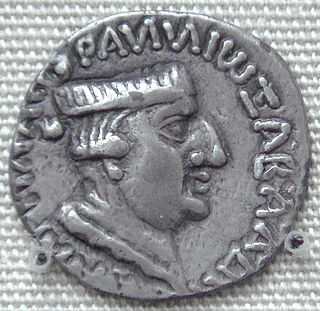
Nahapana was an important ruler of the Western Kshatrapas, descendant of the Indo-Scythians, in northwestern India. According to one of his coins, he was the son of Bhumaka.
Gautamiputra Satakarni, also Gautamiputra Yajna Satakarni, was a ruler of the Satavahana Empire in present-day Deccan region of India. He ruled in the 2nd century CE, although his exact period uncertain. His reign is dated variously: 86-110 CE, c. 103-127 CE, or 106-130 CE.

Rudradaman I was a Saka ruler from the Western Kshatrapas dynasty. He was the grandson of the king Chastana. Rudradaman I was instrumental in the decline of the Satavahana Empire.
The Ikshvaku dynasty ruled in the eastern Krishna River valley of India, from their capital at Vijayapuri during approximately 3rd and 4th centuries CE. The Ikshvakus are also known as the Andhra Ikshvakus or Ikshvakus of Vijayapuri to distinguish them from their legendary namesakes.
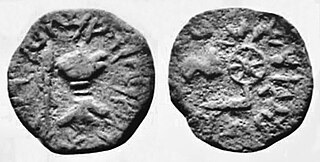
Bhumaka was a Western Kshatrapa ruler of the early 2nd century CE. He was the father of the great ruler Nahapana, according to one of the latter's coins. He was preceded by Abhiraka (Aubhirakes), of whom a few coins are known.
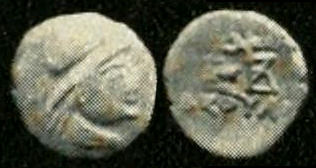
Liaka Kusulaka was an Indo-Scythian satrap of the area of Chukhsa in the northwestern South Asia during the 1st century BCE.
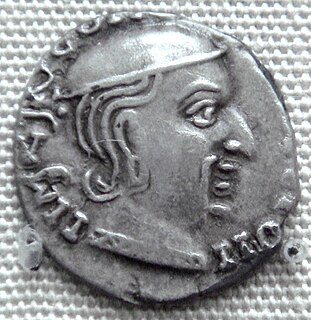
Jivadaman was a Saka ruler of the Western Kshatrapas in northwestern India from during the 2nd century CE. He was the son of Damajadasri I (170–175), and the brother of Satyadaman.
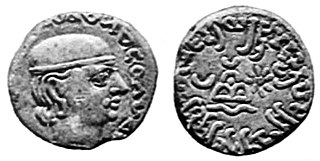
Damajadasri I was a ruler of the Western Kshatrapas dynasty. His reign saw the decline of dynasty after his dominions were conquered by the Satavahanas and saw the rise of the Abhiras in the south and Malavas in the north. He is also known as Damaysada, Damazada or Damaghsada. Jha and Rajgor considers Damajadasri and Damazada different persons.

Jayadaman was a Western Kshatrapa ruler, although possibly only a Kshatrapa, rather than a Mahakshatrapa. He was the son of Chastana, and the father of Rudradaman I, but he may have pre-deceased Chastana, and never ruled as supreme ruler of the Western Kshatrapas. This is suggested by the fact that Chastana and Rudraman I are known from contemporary Indian inscriptions to have ruled jointly.

Rudrasimha I was a Western Kshatrapa ruler, who reigned from 178 to 197 CE. He was son of Rudradaman I, grandson of Jayadaman, and grand-grandson of Chashtana.

Damasena was a Western Kshatrapa ruler, who reigned from 223 to 232 CE. From the reign of Rudrasimha I, the date of minting of each coin, reckoned in the Saka era, is usually written on the obverse behind the king's head in Brahmi numerals, allowing for a quite precise datation of the rule of each king. This is a rather uncommon case in Indian numismatics. Some, such as the numismat R.C Senior considered that these dates might correspond to the much earlier Azes era instead.





















